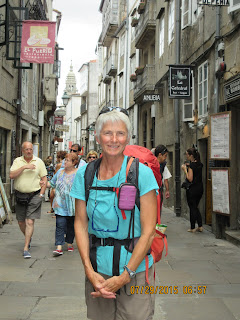Galicia is famous for its seafood and in particular pulpo or octopus. I noticed that almost every eating establishment whether it be a restaurant or bar had pulpo on the menu so of course.....
After Lugo, the route was less mountainous and passed through a stream of small villages and towns. There was more road walking than pathway but the traffic on these roads was minimal. The horreos, structures designed for storage that I mentioned in a previous entry, now have a more rectangular look. I really like this photo with the contrast between the old horreo and the modern windmills.
Cloud and mist continued to predominate but the temperatures were still in the mid 20's, so a very comfortable walking temperature for me.
On the 27th of July I passed through a small town called Melide where the Primitive Route and the French Route unite and this of course meant many more pilgrims would be walking the route and looking for beds. I stopped for the night in Arzúa and calculated there was still about 38 km to reach Santiago. It would be the longest stretch I had done so far, but from this point on, all the hostals were large and would be overflowing with visitors. At 11:00 am in the morning, these mostly young students, already done walking for the day, were waiting for the hostal to open its doors.
One of the last hostals before Santiago is Monte Gozo with 500 beds!!! Approaching this site, which is famous because it was visited by one the the Popes, I could hear the voices of young people singing and cheering and no offense.... I understand their excitement but I did not want to spend my last night in that atmosphere so I continued on. I still managed to find sections along the route uncrowded especially in the afternoon when most pilgrims had chosen a hostal and stopped for the day.
Galicia has a Celtic culture rich with legends and myths and much of it to do with witches. It is such a special feeling walking through these dense, quiet forests only hearing the sound of your own footsteps and a chorus of frogs and birds.
And still there is camino art.
There are so many historically significant spots along all the routes and I find the history of this town interesting and a little humorous.
Today Lavacolla is the sight of the airport that serves Santiago but historically it had the last river the pilgrims would cross prior to reaching Santiago. Wanting to arrive clean before visiting the Cathedral they would bath in this small river. There are a few versions of the origin of the name Lavacolla. One is that Lava comes from the Spanish word lavar or wash and colla means scrotum. OK...so I hope no one is offended and enough history for this entry.
This next sign was also a first on the route. Sello means stamp, and you need to collect stamps from the hostals, churches, bars, etc on your credential to prove that you walked at least 100 km to receive the Compostela or certificate of completion. Even with the Spanish spelling, the second offer is obvious.
The sellos or stamps are all unique, colorful and sometimes very artistic.
Thirty-eight km seems like a long way but after so many days of walking, I was well accustomed to the distances.
These 3 fellows I had come to think of as the Three Musketeers...Zach, Kasper and Andreas. They were planning to walk 3 more days to Finisterre and at this point I was still struggling with that decision.
And what a varied group this was; Spain, Denmark, Sweden and France...and Canada.
These are only a few of the many pilgrims I met along the way as they just happened to be in the plaza at the moment I passed through on the way to my room.
To all those people who I met and parted ways with, I want you to know how much you have enriched my life in the time we shared together. Perhaps our ways may meet again and perhaps not but to ALL, I wish you BUEN CAMINOS ALWAYS!
To all those people who I met and parted ways with, I want you to know how much you have enriched my life in the time we shared together. Perhaps our ways may meet again and perhaps not but to ALL, I wish you BUEN CAMINOS ALWAYS!
I decided to treat myself to a private room and was lucky to find one in the San Martin Pinario Monastery. Oh..... the joy of sheets and a towel! No shortage of great food in Santiago and I chose a tapa tour instead of the many offered Pilgrim's Meals.
The following morning I still was undecided about what to do with my precious few days. I had until noon to leave the Monastery and took that time to research my options. I had considered visiting the coastal city of Vigo in Galicia and while researching I discovered that a short distance away by ferry, it would be possible to visit one of 4 archipeligos just off the west coast of Galicia. The entire archipelago is designated as a National Park of Galicia and I chose the Céis Archipelago consisting of 3 islands. The photos looked stunning. There would be beaches and a little hiking so I would not stop walking cold turkey.
One last photo leaving Santiago...
and I was ready for another adventure.
Off to Vigo.....


















No comments:
Post a Comment